Volterra & the wine hills of Pisa
Etruscan antiquities of Volterra, the wineries of Terriciola and the Pisan hills, the spa resort of Casciana Terme, Andrea Bocelli’s Teatro del Silenzio in Lajatico

Volterra – Etruscan Antiquities
The town of Volterra stands on a high mountain, offering spectacular views across the Cecina Valley to the Tyrrhenian Sea. Such a seemingly inconvenient location should not seem strange – after all, in ancient times Velatri (Volterra) was the capital of one of the most powerful Etruscan principalities, and the Etruscans built all of their capitals at the most inaccessible heights. Of all the cities of Tuscany, it is Volterra that is still the main witness to the existence of the Etruscan people, who subsequently submitted to the ancient Roman state.

If about many Italian cities it is often said that history stopped there hundreds of years ago, then about Volterra it would be fair to say that history has not been in a hurry here for two millennia. Volterra is a city in which each new era did not cancel, did not destroy the previous one. From the Etruscans, the Acropolis with the ruins of temples and almost entire fortress walls of the 4th century BC, as well as a huge collection of Etruscan art in the Archaeological Museum of Guarnacci, have reached us. The magnificent theater and the ruins of the thermal baths have survived from Roman times.

It makes little sense to list the surviving medieval monuments, because the Middle Ages are the “newest” era in this city, whose appearance has hardly undergone any changes over the past seven centuries. Suffice it to mention the main ones – the Baptistery and the amazing Cathedral, which has two facades at once. The first “normal” façade on the west side of the building was commissioned by the local bishop. After the overthrow of his power in the 12th century, the local commune ordered to build a new eastern facade overlooking the «communal» square, the buildings of which have also survived to this day. The most “modern” significant building in Volterra is the citadel, built by the Florentine invaders after the city was subdued by the Florentine Republic in 1472. Apparently, because of the “living” breath of history, felt throughout this eternal city, the American writer Stephenie Meyer in her novel “New Moon” settled the immortal vampires of Volturia in Volterra.

Pisa wine road
Great (yet) unknown wines. Pisa, once the main maritime city of ancient Etruria, is located on a land where the tradition of winemaking has existed for more than three millennia. Today, Tuscany, along with Piedmont, is the main wine region of Italy (for a detailed description of the history and modernity of Tuscan winemaking, see here). It should be noted that the Pisa wines, despite the outstanding geological, geographical and climatic characteristics of the local wine-growing zone, are not yet among the most famous in Tuscany, like the “Classics” of Brunello or the “Super Tuscans” from Bolgheri. It is hoped that the unfair underestimation of the wines produced in the province of Pisa will soon be overcome. These are not empty words – in the Pisan lands, on an old vine, they make strong, long-lived wines with a great palette and structure, which are offered at very reasonable prices. This situation is due to the fact that Pisa’s winemaking is still largely outside the “global economy” and is represented by a mosaic of dozens of small farms, many of which have old vineyards for 40-90 years. The main problem of Pisa wines is their lack of promotion, or rather, the absence of a strong regional brand-appellation, like Brunello.

From a geographical point of view, in the province of Pisa, two main wine-producing regions can be distinguished – the northern “region of the Leaning Hills” which starts from the historic road between Pisa and Florence between Pontedera and San Miniato and runs along Palaia, Terricciola, Peccioli and Lajatico all the way to Volterra The center of this wine region is the town of Terricciola. The second area is located in the south of the province to the west of the “Etruscan” city of Volterra, reaching almost the sea just north of the capital of supertuscan wines, Bolgheri. The centers of this wine region are Montescudaio and Riparbella.
Traditionally, the most famous red wine in the province of Pisa remains the Chianti delle Colline Pisane DOCG (including the “superiore” and “riserva”), which is based on the ubiquitous grape variety Sangiovese in Tuscany (min. 70% + others red varieties allowed in the region). The Pisa Chianti, often with outstanding qualities (for example, the Buscheto of the La Gimonda winery), however, is doomed to remain in the shadow of the main Tuscan Chianti – Chianti Classico and therefore cannot become the locomotive of Pisa’s winemaking. The same Sangiovese variety (min. 50%) is the main ingredient in the “wines of the Hills of Central Etruria” – Colli dell’Etruria Centrale DOC, produced in most of the entire Tuscany region, including in Pisa. The main Pisa white – Bianco di San Torpè DOC (blend of Trebbiano Toscano – 75% with Malvasia Toscana and Canaiolo Bianco) is now in little demand, due to the fact that the white variety Trebbiano, which forms its basis, “came out of fashion “.
Of greatest interest in the “wine hills” of the province of Pisa is its newest wine appellation Terre di Pisa DOC, approved in 2011. The wine zone operates on the territory of the municipalities of Capannoli, Crespina Lorenzana, Fauglia, Lajatico, Montopoli Val d’Arno, Orciano Pisano, Palaia, Peccioli, Ponsacco, Pontedera, San Miniato, Santa Luce e Terricciola. On the part of the wineries and the administration of the province of Pisa, active work has finally begun to promote it, and on December 6, 2018, a specialized Consortium for the protection of wines DOC Terre di Pisa was established in Pisa (Denominations of controlled origin “Terre di Pisa” – Land of Pisa). The core of the consortium was seven wineries from the Pisa district: Badia di Morrona (Terricciola), Tenuta di Ghizzano (Peccioli), Castelvecchio (Terricciola), Usiglian del Vescovo (Palaya), Podere La Chiesa (Terricciola), Fattoria Fibbiano (Terricciola), Fattoria Fibbiano (Terricciola) Spinetta (Terricciola). The Terre di Pisa DOC production regulations regulate the production of two red wines. The first “common” wine Terre di Pisa Rosso should have as a base in 70% Sangiovese, Cabernet Sauvignon and Franc, Merlot and Syrah (together or separately), with which other “red” varieties allowed in Tuscany can be combined, in quantity not exceeding 30%. The second wine, Terre di Pisa Sangiovese, must have at least 95% Sangiovese and therefore represents one of the strictest examples of classic Tuscan wine based on this variety in Tuscany and in Italy in general.
The main wine region of the southern maritime province of Pisa is the Montescudaio DOC appellation, located between the ancient city of Volterra (in the east) and the Tyrrhenian coast (in the west), where white and (mostly) red wines are made. In this area, the local Sangiovese is traditionally accompanied by the international varieties Merlot, Cabernet Sauvignon-Franc, Syrah, Petit Verdot, Vermentino, Chardonnay and Sauvignon Blanc. Montescudaio DOC wines are the closest relatives of the great “Super Tuscan” people from Bolgheri, located just to the south. The excellent combination of good soil and climate, favorably influenced by the proximity of the sea, contributes to the production of high quality wines with a rich palette and structure. In addition, in the southern part of the province of Pisa in Monteverdi Marittimo, there is a small production area of the famous “coastal” wines Val di Cornia DOCG.
In addition to the above wines, of particular interest in the province of Pisa are numerous wines of the conventionally “non-prestigious” category IGT – Indicazione Geografica Tipica Toscana (wines of “typical geographical indication of Tuscany”). Some producers in the province of Pisa offer excellent wines under the IGT label, which, however, do not fall under the restrictions of the DOC and DOCG categories. Most often these are long-lasting “supertuscan” wines with an excellent structure, provided by an accurate selection of grape varieties, careful vinification. In the vicinity of Ghizzano and Terricciola an interesting example of this strategy is the wineries Tenuta di Ghizzano, Podere la Chiesa and Podernovo, which produce the traditional Chianti, Terre di Pisa but also the magnificent IGT supertuscany. The same strategy is followed by producers from San Miniato Varramista (traditionally loyal to the Syrah variety – outside the DOC category), Pietro Becconcini (producing wines based on the local Tempranillo clone found in the Lean ing hills) or La Gimonda, whose flagship “supertuscany” Vicere is rated at the best Brunello. In the south of the province, we meet both adherents of the traditional DOC Montescudaio brand and producers who do not always follow its restrictions, such as, for example, well-known wineries that have already become famous and received top marks from Parker and Sackling – Duemani, Castello del Terriccio, Caiarossa and others, relying on French varieties.

Terricciola. Capital of Pisa winemaking
Thirty minutes from Pisa on the way to Volterra and San Gimignano, not far from the thermal resort of Casciana Terme is the ancient town of Terricciola. It ca n be called a textbook borgo “small” Tuscan city – it stands on the top of a hill covered with vineyards and olive groves, and consists in fact of one main street, stretching along the ridge of the hill and densely built up old 3-4-storey houses standing without gaps … This picture is typical for all the cities of Tuscany, founded by the Etruscans, to protect themselves from enemy attack, they always built their close cities in the most remote and highest place. The Tuscan cities built by the Romans, as a rule, stand on a plain, most often they grew out of military camps of a strict square-rectangular shape withtei a regular grid of streets intersecting at right angles (a typical example is Lucca and Florence). In Terricciola, as in most Etruscan cities, the main treasures of this ancient great culture are hidden under the surface of the earth in numerous necropolises and burials. A significant part of the present Terricciola is located above the catacombs of ancient underground passages and galleries, created by the Etruscans for burials and converted in the Middle Ages into cellars for storing wine and grain. Of the entire Etruscan necropolis of Terricciola, the most interesting is the so-called. The Belvedere Hypogeum, consisting of six burial chambers, carefully surveyed and renovated in 2002.

The city of Terricciola, surrounded on all sides by vineyards belonging to dozens of local wineries, is considered the wine capital of the province of Pisa. The local winemakers are especially proud of the presence of a large number of good old vines, primarily the traditional Tuscan red varieties Sangiovese, Canaiolo, Colorino, Cilegiolo, as well as white Trebbiano, Malvasia, Colombana. The old vine is used to make strong, long-lived wines with an excellent palette and structure, which are offered at very reasonable prices. I have repeatedly witnessed how exactly in Terricciola, connoisseurs and wine lovers, who had not previously considered “all these Chianti” (that is, wines based on Sangiovese) as full rivals to great wines from international varieties, admitted that they found wine here “better than Sassicaia itself “. Despite the outstanding geological, geographical and climatic characteristics of the local wine-growing area, wines from Terricciola are not yet among the most famous in Tuscany, like Brunello or the great “Super Tuscan” from Bolgheri and Chianti Classico. To summarize, it can be argued that good and often great wines are made under Terricciola, but they still do not know how to sell it, which, however, can only be beneficial for the end consumer, since local great wines cost significantly less than their “fair” price.
Casciana Terme Spa Resort
The second most famous Pisa water resort after the famous San Giuliano Terme – Bagni di Pisa is the thermal town of Casciana Terme, located among green hills and vineyards on the way from Pisa to Lajatico, the birthplace of Andrea Bocelli, and the ancient Etruscan capital of Volterra. The local baths owe their origin to Countess Matilda di Canossa, who built her own bath here at the beginning of the 12th century. According to local legend, the countess discovered the future secret of her unfading beauty after her old hand thrush, having bathed in the waters of Casciana, turned from gray-haired to black again, after which the countess herself decided to experience the effects of a miraculous source. Two centuries later, at the beginning of the 14th century, the dilapidated baths were rebuilt by the Signor of Pisa Federico de Montefeltro (not to be confused with Signor Urbino and the Renaissance patron). Since the 16th century, the development, expansion and improvement of Casciana Terme has been a constant concern of the great dukes of Tuscany. In the middle of the 19th century, after the construction of a new grandiose thermal complex by the architect Giuseppe Poggi, Casciana Terme became one of the main “pearls of the waters” in all of Italy. A century later – in the 1960s, the resort was rebuilt again, its capacity increased to 1000 people, and in 2000 it was supplemented with a new spa center with aesthetic treatment rooms, massage, sauna and Turkish bath. Unlike the “Pisa Baths” in San Giuliano, the thermal complex of Casciana Terme does not belong to one hotel – here it is a consortium of ten hotels of different price levels, restaurants, bars, shops, as well as a hospital, a rehabilitation center with five gyms and an outpatient clinic. Healing waters of Casciana, enriched with carbon dioxide, hydrocarbons and numerous mineral salts, have a constant temperature of 37 ° C and help with varicose veins, rheumatism, arthritis, gout, high cholesterol, chronic ENT diseases and gynecological disorders.

Lajatico and the “Teatro del Silenzio” by Andrea Bocelli
The tiny town of Lajatico stands halfway from Pisa to the ancient Etruscan city of Volterra. Despite its chamber dimensions, Lajatico turns into one of the world’s musical capitals every year. The fact is that Lajatico is the hometown of Andrea Bocelli, today the most famous tenor on the Italian opera and pop scene. The future singer was born in Lajatico among the wine hills of Pisa on September 22, 1958. As a child, Andrea Bocelli suffered a tragedy – at the age of 12, after a head injury, he gradually lost his sight. This did not prevent him from graduating from school and obtaining a law degree at the prestigious University of Pisa. In addition to his university studies, the young Bocelli devoted himself to exercises in music and vocals, a passion for which was born in his childhood, which soon brought him general Italian and worldwide fame.

Theater of Silence. Becoming a world star, Andrea Bocelli did not forget about his “small homeland”, he turned his native Lajatico into the stage of one of the main performances in the world musical calendar. Every year, since 2006, at the height of summer, Andrea Bocelli has given a concert in the Teatro del Silenzio, specially equipped on the outskirts of Lajatico. The theater owes its unusual name to the fact that it is “in a state of silence” throughout the year and “comes to life” for one or two evenings during concerts of the great tenor. According to the original idea of the maestro, the “theater” was created for one show a year. The theater consists of “tribunes” and “parterre”, set up on the slopes of the hills, and a round “stage” with a radius of more than ten meters, in the center of which a new set design is mounted every year. The most famous of them, which has become a symbol of the theater itself, is the monumental sculpture depicting a human face, created by the Polish sculptor Igor Mitorai for the production of Manon Lescaut in the first season of 2006 and subsequently donated by the sculptor to the theater fund. The open-air theater is also notable for the beauty of the surrounding landscapes – it is located among the fields and vineyards of Tuscany, where the great Etruscan civilization once flourished.

Visiting Bocelli. The Bocelli family has owned the estate in Lajatico for almost three centuries, its first owner back in the 1730s was the “patriarch” Bartolomeo Bocelli, who planted vineyards here and planted olive trees. Today, the Bocelli family cultivates wheat, olive trees and vineyards up to 70 years old on 120 hectares of their own land, creating excellent wines based on the classic Tuscan varieties of Sangiovese, Canaiolo, Colorino, Malvasia and Trebbiano, as well as the international variety Cabernet Sauvignon. The Bocelli family invites everyone to stay at their agriturismo estate, where guests will receive a warm welcome, wine tastings, excellent Tuscan cuisine, and maybe a meeting with the legendary tenor, if at that moment he finds himself in his ancestral nest, having come to stay with relatives with of his villa not far from Forte dei Marmi.
Where to stay in Volterra and Pisa’s wine hills region. Hotels and agritourism:
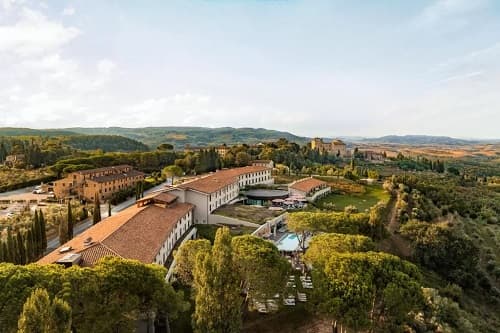
The luxurious modern five-star golf hotel Il Castelfalfi 5 * is located on the road from Pisa and Peccioli-Terricciola to San Gimignano. It features a golf course, swimming pool, 3 restaurants and a bar, a wellness center, and a conference and banquet facilities. Access to La Spa is included in the rate – booking.com
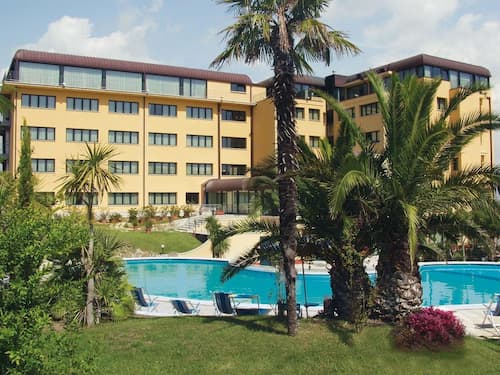
The five-star spa hotel San Marco & Spa 5 * is located in the thermal town of Casciana Terme on the road from Pisa to Terricciola and Volterra. All hotel rooms have a patio with garden views. It features a restaurant, bar, shared lounge, garden, spa and wellness center– booking.com
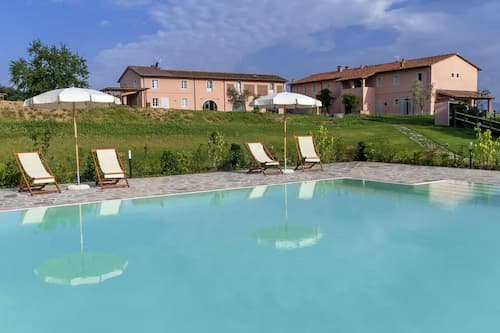
The four-star hotel Le Sodole Country Resort & Golf 4* is located among the vineyards near Pontedera and the superstrada between Pisa and Florence. It offers self-catering accommodation, a golf course, a free outdoor pool and a spa with Turkish bath, sauna and fitness center – booking.com
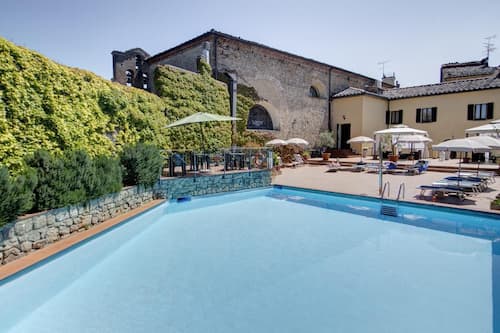
The four-star hotel San Lino 4* is located in the center of Volterra, 5 minutes walk from the main square, Piazza dei Priori. It offers a garden with an outdoor pool and a sun terrace with panoramic views and a garage on site – booking.com
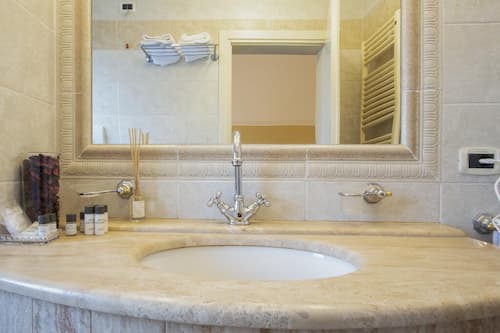
The four-star hotel La Locanda 4* Tis located in the center of Volterra, a few steps from the Roman Theater and the Porta Fiorentina gate. The hotel is set in a former monastery complex with a small inner garden. Some rooms have a spa bath or hydromassage shower – booking.com
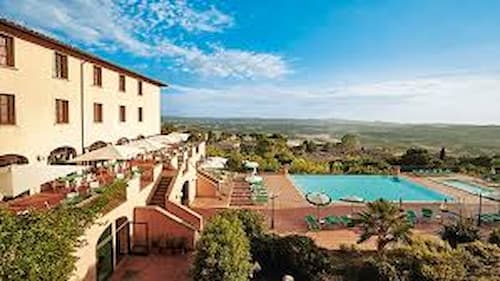
The four-star Park Hotel Le Fonti 4* is located a 10-minute walk from the center of Volterra. It offers a wellness center (surcharge), 2 swimming pools with panoramic views, Il Brachettone Tuscan restaurant with an extensive wine list. Panoramic views from the restaurant terrace – booking.com
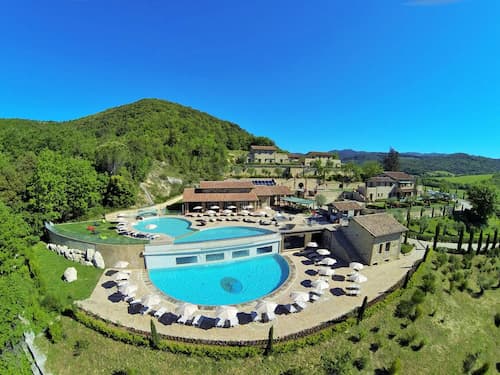
The four-star hotel Fonte Alla Lepre 4* is located near the town of Riparbella on the road from Volterra to the sea. It offers a swimming pool with sun loungers, a garden, a terrace and a restaurant, for an additional fee – a wellness and spa center with a sauna, Turkish bath, multi-sensory shower and relaxation area, a heated pool and a hot tub – booking.com
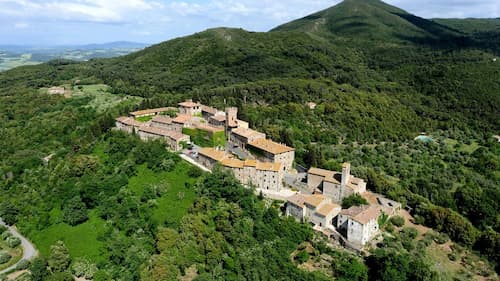
Castle-agriturismo Castello Di Querceto is located in the vineyards of the wine estate of the same name. It offers apartments with a kitchenette, seating area and garden views. It offers an outdoor pool, gourmet restaurant, free wine tasting – – booking.com
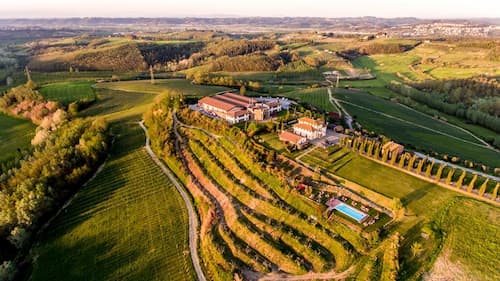
Agriturismo Casale Podernovo is located a stone’s throw from Terricciola among the vineyards of the winery of the same name, owned by the Tenute Lunelli group, the producer of the famous Italian sparkling wine of the classic method Giulio Ferrari Trento Doc. It offers air-conditioned apartments with garden views and a fully equipped kitchen and dishwasher, a garden, an outdoor heated pool – booking.com



